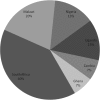Representation of developing countries in orthopaedic journals: a survey of four influential orthopaedic journals
- PMID: 22588702
- PMCID: PMC3392367
- DOI: 10.1007/s11999-012-2377-5
Representation of developing countries in orthopaedic journals: a survey of four influential orthopaedic journals
Abstract
Background: The developing world contains more than ¾ of the world's population, and has the largest burden of musculoskeletal disease. Published studies provide crucial information that can influence healthcare policies. Presumably much information regarding burden in the developing world would arise from authors from developing countries. However, the extent of participation of authors from the developing world in widely read orthopaedic journals is unclear.
Purpose: We surveyed four influential English-language orthopaedic journals to document the contributions of authors from developing countries.
Methods: We surveyed Clinical Orthopaedics and Related Research, Journal of Orthopaedic Trauma, and the American and British volumes of The Journal of Bone and Joint Surgery, from May 2007 through May 2010. The country of origin of all authors was identified. We used the designations provided by the International Monetary Fund to define countries as either developed or developing.
Results: Two hundred sixty-five of 3964 publications (7%) included authors from developing countries. Ninety percent of these had authors from developing countries with industrialized and emerging-market economies. Publications from Sub-Saharan Africa accounted for only 0.4% of the 3964 articles reviewed and 5.6% of the 265 articles with developing world authorship. Countries with the least robust economies were least represented. Less than 1/3 of articles with authors from the developing world had coauthors from developed or other developing countries.
Conclusion: Additional studies are needed to determine the reasons for the low representation noted and to establish strategies to increase the number of orthopaedic publications from parts of the world where the burden of musculoskeletal disease is the greatest.
Figures



References
-
- Beveridge M, Howard A. The burden of orthopaedic disease in developing countries. J Bone Joint Surg Am. 2004;86:1819–1822. - PubMed
-
- Central Intelligence Agency. CIA World Factbook. Available at: https://www.cia.gov/library/publications/the-world-factbook/. Accessed December 22, 2011.
-
- Dormans JP. Orthopaedic surgery in the developing world: can orthopaedic residents help? J Bone Joint Surg Am. 2002;84:1086–1094. - PubMed
-
- Eigenfactor.org™. Ranking and mapping scientific knowledge. Available at: http://www.eigenfactor.org/. Accessed December 22, 2011.
MeSH terms
LinkOut - more resources
Full Text Sources

